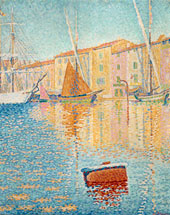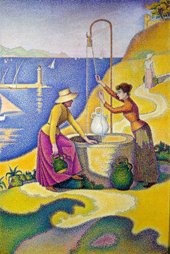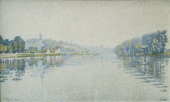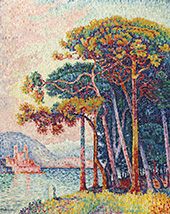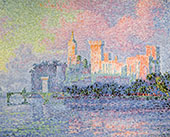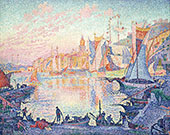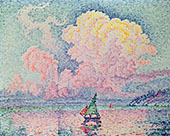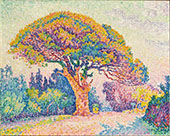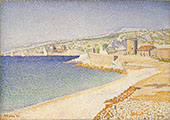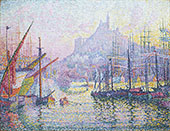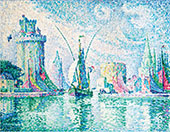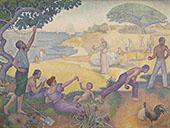Paul Signac Oil Painting Reproductions
Paul Signac replica paintings on Canvas for sale
Paul Signac Pointillism Paintings
Paul Signac was a prominent French artist associated with the Neo-Impressionist art movement. He employed Pointillism, a painting technique that utilizes small dots of color to create lively and energetic artworks.
In addition to his contributions to the art world, Signac was a strong advocate for the arts. He was a founding member of the Société des Artistes Indépendants. Paul Signac helped organize the Salon des Indépendants, a yearly art show for new and experimental artists.
Who was Paul Signac
Born on November 11, 1863, in Paris, France Paul Signac started as an apprentice to a painter. Claude Monet and Georges Seurat strongly influenced him in developing Neo-Impressionist painting.
Signac came from a wealthy family and initially pursued a career in architecture. However, his passion for art led him to abandon his study of architecture and dedicate himself to painting.
He began his artistic education by attending the École des Beaux-Arts in Paris. There, he studied under the guidance of famous artists such as Émile Bin and Armand Guillaumin. During this time, he encountered the works of the Impressionist artists. The Impressionists influenced his artistic style and his reputation as one of the most famous pointillism artists.
Paul Signac paintings often depict landscapes and seascapes, mainly Mediterranean landscapes. He painted beautiful oil paintings of the places he visited, using bright colors and detailed brushstrokes. His famous works include The Port of Saint-Tropez and The Mediterranean at Collioure.
Signac's legacy continues to influence artists and art enthusiasts today, and his works can be found in museums and galleries worldwide. Paul Signac's most famous paintings include The Dining Room, Opus 152, Woman at the Well, The Port of Saint-Tropez, and The Red Buoy Saint-Tropez.
Paul Signac and his friendship with the famous Impressionist Claude Monet.
Signac's friendship with Claude Monet began in the late 1880s when they met at an exhibition. They shared a mutual admiration for each other's work and quickly formed a strong bond. Monet's use of color and light in his paintings profoundly influenced Signac.
Together, Signac and Monet explored new techniques and approaches to painting. They were both interested in capturing the fleeting effects of light and atmosphere in their artwork. Signac's experimentation with Pontillism paintings creating small dots or strokes of color to create bright and vibrant paintings began.
Paul Signac's friendship with Monet lasted until the latter died in 1926. Their teamwork and sharing of ideas greatly influenced both artists and the growth of Impressionism and Post-Impressionism.
In conclusion, Paul Signac's friendship with Claude Monet was a significant influence on his artistic career. They both loved capturing light and trying new techniques. This helped create Neo-Impressionism and the Pointillism art movement.
Vincent van Gogh's Post-Impressionist paintings and Paul Signac's Pointillism art.
Vincent van Gogh and Paul Signac did meet and had a brief but impactful interaction. They met in Paris in 1886 when van Gogh was still developing his artistic style. Signac introduced van Gogh to the technique of pointillism, which had a significant influence on van Gogh's later work.
During their meeting, Signac showed Vincent van Gogh some of his Pointillism paintings and explained the technique. This innovative approach to painting intrigued Van Gogh, and he began experimenting with it in his work.
Van Gogh's style changed after learning from Signac's technique. This was important for his artistic growth. However, Van Gogh he moved away from Pointillism developing his unique and distinctive style of oil painting.
Vincent van Gogh characterizes his oil paintings with emotional expression and bold brushstrokes. Paul Signac's paintings use Pointillism and scientific color theory, applying small dots of color for a unique effect. Nonetheless, their meeting allowed for an exchange of ideas and artistic exploration.
While their encounter was brief, the meeting between van Gogh and Signac represents a significant moment in art history. It demonstrates how artists can inspire and influence each other, even if their styles and perspectives differ.
Paul Signac's friendships included many other famous artists of the day, including Camile Pissarro and Henri Matisse. At the Salon des Independants exhibition in 1905, Henri Matisse exhibited one of his famous paintings Luxe, Calme et Volupte, which Paul Signac purchased.
Love of the Sea and Famous Paintings.
One of Signac's most famous paintings, The Port of Saint-Tropez, depicts the picturesque Mediterranean landscape and showcases his mastery of pointillism. This painting, along with many others by Signac, reflects his love for the sea and his fascination with the play of light on water. He created several paintings that featured sailing boats and maritime scenes.
Signac's fascination with sailing and boats is also evident in other oil paintings, such as The Bonaventure, The Port of Rotterdam, and The Bonne Mer. These oil paintings depict various aspects of maritime life, including sailboats, harbors, and Mediterranean coastal landscapes.
Signac's Legacy and Contribution to the World of 19th century paintings.
Paul Signac was a significant artist. He had a major impact on the art world. He achieved this through his work and involvement with the Salon des Indépendants. He was President of the Salon from 1908 until his death in 1935.
The Salon des Indépendants was an annual art exhibition in Paris that aimed to promote innovative and avant-garde art. Signac, along with other artists, organized and curated the exhibition, providing a platform for artists to showcase their works outside of the traditional art establishment.
Through his involvement with the Salon des Indépendants, Signac helped to foster a spirit of artistic independence and experimentation. He encouraged artists to break away from conventional artistic norms and explore new techniques and approaches to art.
Discover the world of Paul Signac art and the pointillism paintings by Georges Seurat and Signac. Our our extenslve online collection of reproduction oil paintings offers famous paintings of the worlds greatest modern art.
Cannot Find What You Are Looking For?
Reproduction Gallery Information
Customer Service
(Send Us A Message)
Tel: (503) 937 2010
Fax: (503) 937 2011


